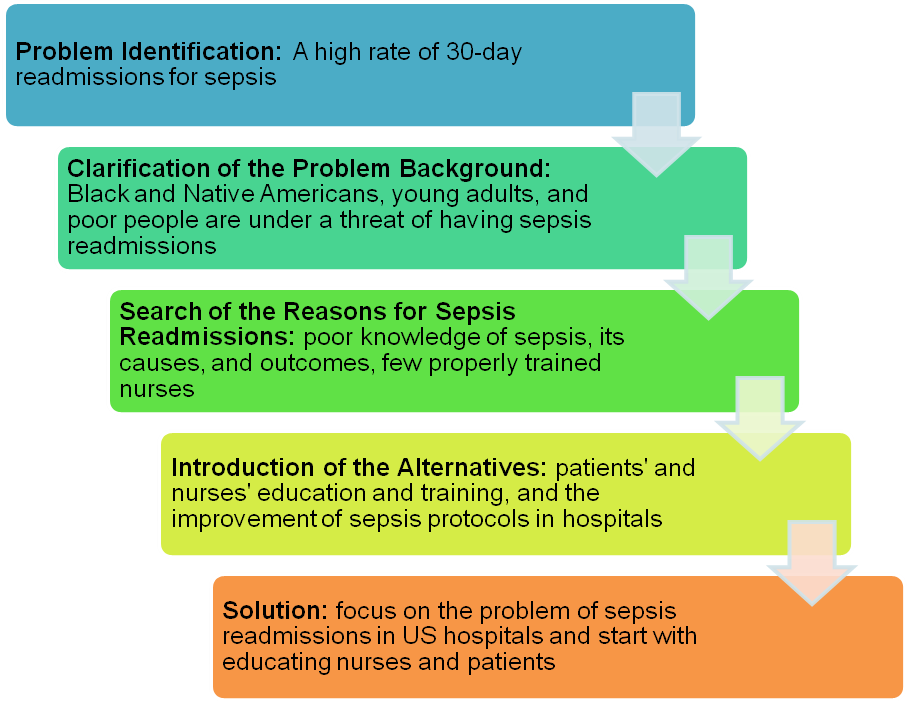Issue Identification
Nowadays, sepsis is defined as one of the frequent life-threatening complications of infections people may suffer from (Dlugacz 250). It is usually characterized by the 30-day and 180-day readmissions among sepsis survivors. The investigations of Goodwin et al. show that hospital readmissions remain to be common implications for patients and society (738). In comparison to evident improvements of the Affordable Care Act and the creation of national initiatives that help to reduce the number of readmissions for heart attacks and failures, there are no certain national programs that discuss the peculiarities of readmissions for sepsis (Rivero). As a rule, readmissions determine the quality of life and become a crucial cost burden for the USA (Goodwin et al. 738). Readmissions for sepsis may have different reasons and outcomes.
Not all nurses and caregivers are aware of the peculiarities of sepsis and may recognize the early systems of sepsis. Sometimes, nurses start discharge early. Finally, patients may have other health problems that may promote the development of sepsis. Therefore, it is proper to say that 30-day readmissions for sepsis may be associated with such characteristics as nursing training and the level of the staff knowledge, sociodemographics, discharge destination, and comorbidities.
Needs to Be Determined and Effects
Taking into consideration the main challenges and difficulties nurses and patients may face in case of sepsis, it is necessary to discuss this disease in the broadest terms possible and clarify what expectations may be established, and which of them are reachable. Sepsis readmissions have been already defined as the conditions that are targeted for interventions and improvements developed by policymakers (Rivero). According to Sullivan, any decision-making process should have a purpose, certain criteria, and a number of alternatives that could be developed and tested (108).
It is expected to identify the criteria regarding different social, demographic, and other aspects. For example, such groups of people as Blacks and Native Americans, young adults, and people with a low income are under a threat of frequent sepsis readmissions (Rivero). These groups of people, as well as some other patients, admit that they do not know a lot about how to take their medication in a proper way, when to address for follow-up care, and what those discharge practices are all about. Besides, there are many nurses, who have a poor education and poor assessment skills, and cannot develop appropriate anti-sepsis practices because of their fears of physicians or other managers, who could follow their work. In other words, nurse fears and unawareness could promote the development of sepsis readmission rates.
Therefore, it is necessary to determine the level of patients’ and nurses’ awareness of sepsis and the threats of readmissions. The main effect of the practices offered is the reduction of readmissions for sepsis in US hospitals.
Categories of Cause
In the majority of cases, the cause-and-effect diagrams have such categories as equipment, people, materials, and methods (Sullivan 109). In the case of 30-day readmissions for sepsis, the following categories could be identified:
- People: nurses and patients, who have to improve their knowledge of sepsis, its causes, and outcomes on the quality of life in order to avoid complications and deaths.
- Equipment: expensive tests and the inability to have all assessments in time.
- Materials: lack of sepsis protocols that cannot be defined as a part of the assessment.
- Methods: early discharge, poor teaching of patients, and no nurse training.
Contributing Factors
Each category has a number of contributing factors that have to be taken into consideration in each cause in order to introduce an effective solution to the problem known as frequent 30-day readmissions for sepsis.
For example, in the first category, people, there is a lack of knowledge patients and nurses should have about sepsis. In many hospitals, there are no people, who should take responsibility for educating people about the threats of sepsis. In the category “Equipment”, hospitals lack free tests that could be offered to patients, who are going to be discharged. People do not have a full picture of their health at the moment when they leave the hospital. There is also a lack of special materials such as sepsis protocols with the help of which nurses could check their patients. Finally, many hospitals still support the idea of early discharge practices. Patients are not aware of the possibilities of sepsis in their organisms, and nurses fail to explain such cases and threats to their patients.
Alternatives
To change the situation and help patients reduce the number of sepsis readmissions in 30 days, the following alternatives could be offered:
- Free and regular lectures for patients about sepsis and its threats;
- Follow-up care for all patients regardless of their social status, skin color, and age;
- Teaching patients how to take medications in a proper and safe way;
- The introduction of sepsis protocols as a part of the assessment for nurses;
- Regular training and education for the nurse staff.
Diagram

Works Cited
Dlugacz, Yosef D. Introduction to Health Care Quality: Theory, Methods, and Tools. John Wiley & Sons, 2017.
Goodwin, Andrew, et al. “Frequency, Cost, and Risk Factors of Readmissions among Severer Sepsis Survivors.” Critical Care Medicine, vol. 43, no. 4, 2015, pp. 738-746.
Rivero, Enrique. “Hospital Readmissions for Sepsis Are Highly Common, Extremely Costly.”UCLA Newsroom. 2015, Web.
Sullivan, Eleanor J. Effective Leadership and Management in Nursing. 8th ed. Pearson, 2012.